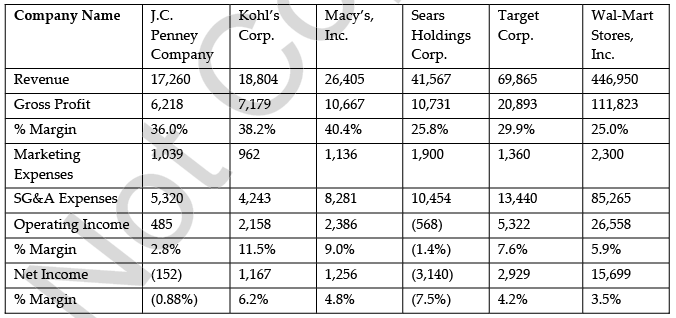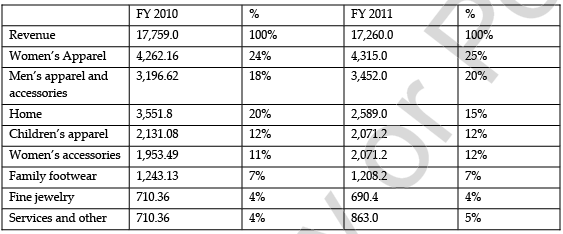Problem Definition
J.C. Penny established in 1902; the main problem of this company was to create a brand image to satisfy existing customers and attract young customers.
Decision Facing the Company
The marketing strategy of JCP based on promotions discounts policy and sales commissions; however, the customers of this company were dissatisfied with a new pricing structure, which needs to change.
Core Value and Positioning Strategy
The core values of the company are to improve and recompense the talents of the workers, work with the maximum moral principles, train prospective workers, celebrate small successes, assist sincere communication, promote the innovative idea and smart risk-taking, and most importantly, to care about the people in the localities.
Target Market
Stock (2013) pointed out that older, less hip, lower-middle-class mothers and shoppers that are older than 55 years of age are the main target market for most department stores; in addition, extremely price sensitive and price-conscious people are loyal customer group of this company because it offered good value for the money (Thompson, 2013). At the same time, this company offered high discounts in order to attract older, price-conscious customers (Thompson, 2013).
Competition
Johnson (2013) stated that Macy’s Inc and Kohls Corporation, Target, Wal-Mart, Foundry Big & Tall Supply stores are the major and closest competitors in the market; in addition, the competition of the market has increased for the enchantment of the retail e-commerce business.
On the other hand, this company faced enormous competition at the time of the global financial downturn because consumers only visited its stores and looking for discounts, offers, and coupons (Johnson 2013). In 2011, net income of Wal-Mart was $15,699 million, Target Corporation was $2929 million while a net loss of JCP was $152 million; however, the following figure gives more information in this regard-

4 P’s Analysis
Product/Service
Ostlund (2012) stated that apparel, accessories, footwear, fine jewelry, furniture, and Sephora beauty care products are the main products of JCP; however, this company generated the highest revenue from women’s apparel segment. The following figure gives more information in this regard-

Price
After assessing the existing high-low pricing structure, CEO of J.C. Penny had introduced new pricing strategy containing three pricing tiers, for instance, price of everyday items reduced by 40%, and value of monthly products decreased by 20-29%; moreover, customer enjoyed special offer on the first and third Friday of each month (Johnson, 2013). The next figure gives more information in this regard-

Promotion
According to Johnson (2013), this company had spent more than US$1200 million to implement about 590 promotion events in 2011, and it had generated 72% of its sales revenue from products with a 50% discount offer and its stock soaring up 24%. However, this strategy failed to solve existing problems of JCP as it was confusing to the customers; moreover, competitors have an enlarged promotional budget to overcome from recessionary impact (Ostlund, 2012 and Kardashian, 2012).
Place Strategy
Johnson (2013) reported that JCP operated about 1100 stores with 41 million square feet of retail space among them it operated 700 stores in metropolitan areas and 400 stores in small-town; however, the CEO of this company identified that JCP was bound to close its outlets due to high rent of retail space and small customer base.
SWOT analysis of J.C. Penney
Table 1: SWOT Analysis
Analysis
Effectiveness of the “Fair and Square” repositioning strategy
CEO of JCP had designed radical makeover known as “Fair and Square” strategy to increase sales revenue and brand awareness; however, he mainly changed the logo, spokesperson, and environment of stores, sales structure, and pricing strategy.
The new brand spokesperson was an efficient strategy since new spokespersons would have the capability to protest the company from controversy and gain a positive image (Johnson 2013). The aim of this company was to create a loyal customer base and build brand image, but a frequent change of logo had confused customers and created a chance of fraud (Johnson 2013).
Indicators are pointing to a possible Need to go back
After implementing the new pricing strategy, the sales revenue had decreased rapidly as it failed to attract both new and old customers; at the same time, employees of this company demoralized, frustrated, and unhappy to execute the new system; thus, “Fair and Square” was a mistake.
Indicators are pointing to a more positive direction
Johnson had endeavored to develop a team of specialists to change the sales structure of the company, which indicated Fair and Square” would potentially succeed; however, the employees had started to sale aggressively, which created controversy.
The key assumptions about JC Penny’s 5 C’s Analysis
Table 2: JC Penny’s 5 C’s Analysis
Repositioning with a new target market
JCP has redesigned its stores to attract younger shoppers as it has only 20% of clients under the age of 35; in addition, older customers are price-sensitive, and they only purchase necessary products; however, removed coupons and reduced promotion were the prime factors of failure (Stock, 2013).
New target with the “Fair and Square” brand repositioning
Older customers liked discounts and bargains while younger and modern customers wanted stylish products; therefore, it redesigned stores and sales structure to simulate the buying structure.
Johnson wanted to attract the new target customer
There were many reasons for trying to attract new customers, such as Macy’s and Kohls gained a competitive advantage, older customers were conscious, face financial hardship, increase sales revenue, develop stock performance and change the overall business environment.
Comparison between existing core customers and a new target of JCP
Table 3
The customer delivers more value to JC Penny
Table 4
Pros and Cons of Different Types of Pricing Strategies
Table 5
Transformation of JC Penny with the radical shift in pricing
It was essential to change pricing policy, but it was only factored to transform; however, competitors occupied a large market share while it strived to survive in the market; therefore, it should focus on the overall transformation of the company.
Attitude and Leadership Approach of Johnson
Johnson was neither genius nor a fool; he had just tried to execute the repositioning strategy and wanted to make the business profitable, but he dealt with a sinking ship. More market research was required to introduce a new strategy, but Johnson has not focused on this issue, and he failed to understand shoppers’ behavior, for instance, consumers loved the bargain hunt, but he removed favorite coupons and sales commissions.
Table 6: Similarities and differences between Johnson and Steve Jobs
Source: Self-generated
Recommendations
JCP should change pricing strategy, increase the budget for promotional activities, conduct more research on the market, and follow retrenchment strategy in order to survive in the retail industry.
Reference List
Isaacson, B. (2013). Lessons in Pricing Strategy from JCPenney. Web.
Johnson, R. (2013). J.C. Penny’s “Fair and Square” Strategy (Abridged). Web.
Kardashian, K. (2012). J.C. Penney, A New Deal. Web.
Ostlund, A. (2012). JC Penney Strategic Marketing Plan 2012: Product Strategy. Web.
Stock, K. (2013). J.C. Penney’s Shoppers are Older, Poorer, than you thought. Web.
Thompson, D. (2013). Who Killed JC Penney? Web.